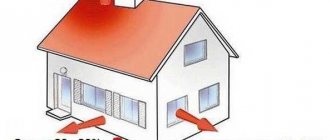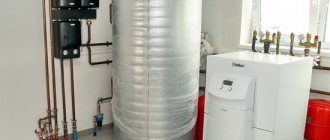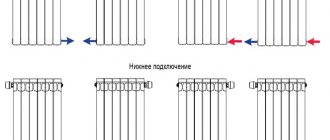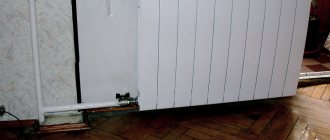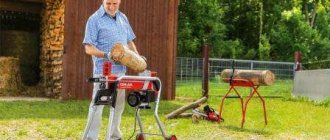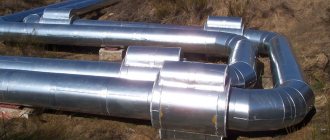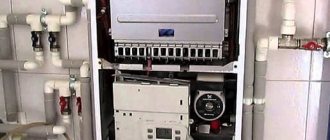If you think that only a specialist with a technical background can understand the design of a hydraulic arrow, then you are mistaken. In this article we will explain in an accessible form the purpose
basic principles of its functioning and rational calculation methods.
Hydroarrow
(synonyms: hydrodynamic thermal separator, hydraulic separator, and in Russian - anuloid) is a device designed to equalize both temperature and pressure in the heating system. To put it simply, we reset the pressure in the supply and the pressure in the brother.
Main functions
- increasing energy efficiency by increasing the efficiency of the boiler and pumps, which leads to lower fuel costs;
- ensuring stable operation of the system;
- eliminating the hydrodynamic impact of some circuits on the total energy balance of the entire heating system (to separate the radiator heating circuit and the heating boiler).
What forms of hydraulic arrow exist?
A hydrodynamic thermal separator is a vertical volumetric container, which in cross section can be in the form of a circle or square
Taking into account the theory of hydraulics, a round-shaped hydraulic needle functions better than its square-shaped counterpart.
Nevertheless, the second option fits optimally into the interior. Before studying the principle of operation of the hydraulic arrow
, pay attention to the diagram below.
Pumps Gp and Gs create flow in the first and second circuits, respectively. Thanks to the operation of the pumps, the coolant circulates in the circuits and mixes it in the hydraulic arrow.
Option 1. If Gp = Gs the coolant moves from one circuit to the second, then the temperature in the primary and secondary circuits is the same.
Option 2. If Gp > Gs, the coolant moves in the hydraulic arrow from top to bottom, and the temperature in the supply circuit will be the same in both the primary and secondary circuits.
Option 3. If Gp < Gs the coolant moves from bottom to top in the hydraulic switch, now the return line temperature is the same in both the primary and secondary circuits.
Based on the above, it follows that the Hydroarrow must be selected according to the maximum flow rate in any of the heating circuits.
Thus, a hydrodynamic thermal separator is needed when there is a heating system that is complex in design, consisting of many circuits.
A little about the numbers...
There are several methods by which the hydraulic arrow is calculated.
The diameter of the hydraulic separator is determined by the following formula:
Where D is the diameter of the hydraulic needle, Q is the water flow rate (m3/s), π is a constant equal to 3.14, and V is the vertical flow velocity (m/s). It should be noted that the economically advantageous speed is 0.1 m/s.
The numerical values of the diameters of the nozzles included in the hydraulic arrow are also calculated using the above formula. The difference is that the speed in this case is 0.7-1.2 m/s, and the flow rate (Q) is calculated for each carrier separately.
The volume of the hydraulic arrow affects the quality of the system’s functioning and helps regulate temperature fluctuations. The effective volume of a heating system with a hydraulic arrow is 100-300 liters.
To determine the optimal dimensions of a hydrodynamic thermal separator, the method of three diameters and alternating pipes is used.
We calculate using the formula:
Where π is a constant equal to 3.14, P is the boiler power (in J), C is the heat capacity of the coolant (for water 4.183 kJ/(kg•°C), W is the speed at which the coolant moves in the hydraulic arrow (m/s ), ΔT is the temperature difference between the heat supply points from the boiler (upper and lower).
( 3 • d ) - indicator calculated by trial and error.
| Boiler power | D pipes from the boiler | D pipe under the arrow |
| 70 kW | 32 | 100 |
| 40 kW | 25 | 80 |
| 26 kW | 20 | 65 |
| 15 kW | 15 | 50 |
Only pros and no cons
Based on the above, the following advantages of using hydraulic arrows can be identified:
- optimization of operation and increase in the service life of boiler equipment;
- system stability;
- simplification of pump ;
- the ability to control the temperature gradient;
- if necessary, you can change the temperature in any of the circuits;
- ease of use;
- high economic efficiency.
In order not to worry about the uninterrupted operation of the heating system, to minimize heat loss, to increase the efficiency of the boiler, and to maintain the temperature in the entire house at the most comfortable and stable level, a hydraulic arrow is needed.
This container stabilizes the distribution of coolant over the entire area of the room, extending the life of the heating system, as it prevents the occurrence of water hammer.
Why do they trust us with the calculation and installation of hydraulic arrows?
You should not install the hydraulic arrow yourself. It’s better to contact our organization because:
- We have experienced design engineers on our staff who will correctly perform all calculations;
- our installation technicians will competently carry out all installation work;
- We will carry out not only commissioning work, but also provide subsequent maintenance;
- People trust us because we do everything with high quality and for many years.
Purpose and principle of operation
The hydraulic arrow (hydraulic arrow, hydraulic separator) serves to separate and link the primary and secondary circuits of the heating system. In this case, the secondary circuit is understood as a set of circuits of heat consumers - underfloor heating loops, radiator heating, hot water supply. Since the load on these subsystems is not constant, the thermohydraulic parameters (temperature, flow, pressure) of the secondary circuit as a whole are also variable. At the same time, for normal operation of the heat source (heating boiler), stability of these characteristics is desirable. The hydraulic arrow installed between the boiler and consumers allows the heat generator to ensure such stability ( Fig. 1
).
Fig.1. Hydraulic arrow in the heating system
The action of the hydraulic separator is based on a significant increase in the cross-section of the coolant flow: as a rule, the hydraulic arrow is designed in such a way that the diameter of its body (flask) is three times the diameter of the largest connecting pipe or so that the cross-section of the body is equal to the total cross-section of all pipes.
When the flow diameter increases three times, its speed decreases by nine, and the dynamic pressure by 81 times (both are quadratic dependencies). This allows us to assert that the pressure drops between the pipelines connected to the hydraulic arrow are negligible.
The use of hydraulic arrows with solid fuel equipment
When using a solid fuel unit, the hydraulic separator is connected at the inlet-outlet point.
This option for connecting different types of heating devices ensures the selection of optimal and individual temperature conditions for all components separately. Today, consumers, having understood how a hydraulic heating device works, prefer ready-made products that are on sale. Select a hydraulic separator from the catalog, based on the power of the unit and the maximum water flow.
Operating modes
When talking about a hydraulic switch, an analogy is often drawn with a railway switch. Their work is indeed similar: both devices set the desired direction of movement, in one case - transport, in the other - coolant. The difference is that “switching” the hydraulic switch does not require any external force, but occurs by itself, depending on the consumption of heat and hot water. The operating modes of the hydraulic separator are discussed below.
Mode 1.
The load on the heating system is such that the primary and secondary flow rates coincide, i.e.
The coolant heated by the boiler is completely transferred to consumers, and there is enough of it ( G
1 =
G
11 =
G
2 =
G
21,
T
1 =
T
11,
T
21 =
T
2).
In this case, the hydraulic arrow is “switched on” directly and operates as two separate pipelines. The movement diagram, chromograms of coolant velocities and pressures in the separator housing are shown for this mode in Fig.
2 . This mode can be called calculated.
Rice. 2.
Mode 2.
The heating system is loaded.
The total consumption of consumers exceeds the flow rate in the heat source circuit ( G
1 <
G
11,
T
1 >
T
11;
T
21 =
T
2;
G
1 =
G
2;
G
11 =
G
21).
The difference in flow rates is compensated by mixing part of the coolant from its “return” into the supply line of the secondary circuit ( Fig. 3
).
mode
is described by the following formulas: Δ T
1 =
T
1 –
T
2 =
Q
/
c
G
1
, Δ
T
2 =
T
11 –
T
21 =
Q
/
c
G 11,
T
2 =
T
1 – Δ
T
1,
T
11 =
T
21 + Δ
T
2.
Rice. 3.
Mode 3.
Heat consumption is reduced (for example, in the off-season), and the coolant flow in the secondary circuit is less than in the primary circuit (
G
1 >
G
11,
T
1 =
T
11,
T
21 ˂
T
2,
G
1 =
G
2,
G
11 =
G
21).
In this case, the excess coolant returns to the boiler through the hydraulic switch, without entering the secondary circuit ( Fig. 4
).
Calculation formulas: Δ T
1 =
T
1 –
T
2 =
Q
/
s
G
1
; Δ T
2 =
T
11 –
T
21 =
Q
/
c
G
11
;
T
2 =
T
1 – Δ
T
1;
T
11 =
T
1;
T
21 =
T
11 – Δ
T
2. This mode is optimal if it is necessary to protect the boiler from so-called low-temperature corrosion.
Rice. 4.
In the absence of flows along the circuits of the heating system, the hydraulic separator does not interfere with the natural (due to gravitational forces) circulation of the coolant, as demonstrated by the chromogram shown in Fig. 5
.
Rice. 5. Chromogram of temperature in static mode
Calculation method
To make a hydraulic arrow for heating with your own hands, you will need preliminary calculations. This figure shows the principle by which the dimensions of a device can be calculated quickly, with fairly high accuracy.
"3d" principle
These proportions were obtained taking into account the results of experiments and the efficiency of the device in different modes. The value of D, which consists of three d, can be calculated using the following formula:
- РВ – water consumption in cubic meters;
- SP – water flow speed in m/s.
In order to fulfill the optimal conditions mentioned above, the value SP = 0.1 is inserted into the formula. The flow rate in this device is calculated by the difference Q1-Q2. Without measurements, these values can be found using data from the technical data sheets of the circulation pumps of each circuit.
Calculator for calculating hydraulic pump parameters based on pump performance
Construction and equipment
Due to the sharp decrease in the flow rate in the hydraulic arrow, its design and spatial arrangement (true for vertical hydraulic separators), this element is an ideal point in the system for removing air and sludge from the coolant. (We note, however, that not all equipment manufacturers implement such functions).
In Fig. 6
.
The hydraulic pointer VT.VAR.00 is shown (diagram, design and dimensions), supplied by VALTEC as one of the modules of the VARIMIX quick installation system. To remove air accumulating in the upper part of the flask, the separator is equipped with an automatic air vent 1
; a drain ball valve
2
.
The air vent is turned off during repairs or maintenance using ball valve 5
.
To control the temperature and pressure in the supply pipeline of the primary circuit, a thermomanometer 3
4
for the temperature in the return pipeline .
On the supply and return pipes there are also sockets for temperature sensors 6
,
7
(plugged with plugs).
The hydraulic separator body is made of OTS 60Pb2 bronze. The technical characteristics of the module are given in table.
1 .
Rice. 6. Diagram and design of the hydraulic needle VT.VAR.00
Table 1. Technical characteristics of the hydraulic gun VT.VAR.00
| Characteristic | Meaning |
| Working pressure, MPa | 1,0 |
| Test pressure, MPa | 1,5 |
| Maximum temperature of the working environment, °C | 120 |
| Permissible ambient temperature, °C | From 0 to +60 |
| Permissible relative ambient humidity, % | 80 |
| Maximum coolant flow, kg/h | 4500 |
| Maximum connected thermal power (at ΔT = 20 °C), kW | 104 |
| Set weight, g | 4500 |
| Connection to collectors | Fitting VT.0 606 1 1/4 |
| Average total service life, years | 50 |
In 2015, VALTEC announced the release of the VT.VAR05.SS stainless steel hydraulic separator. The choice of body material made it possible to reduce the cost of the product, providing it with high strength and corrosion resistance. At the same time, the developers also improved the design of the hydraulic arrow ( Fig. 7
), supplementing it with a perforated partition to reduce heat loss due to convection of the coolant - from approximately 7 to 2-3%, as well as a spiral perforated separator - for more intensive removal of air from the working environment.
Rice. 7. Design of the hydraulic needle VT.VAR05.SS: 1 – pressure gauge, 2 – drain valve, 3 – automatic air vent, 4 – shut-off valve, 5 – additional threaded pipes, 6 – threaded plugs for additional pipes, 7 – spiral perforated separator, 8 – perforated partition
The hydraulic arrow made of stainless steel is equipped with an automatic air vent with a shut-off valve, a drain valve, and a pressure gauge. Additionally, the housing has connections for a thermometer, temperature sensor, and magnetic sludge trap. The separator is designed for heating systems with operating pressures up to 10 bar and temperatures up to 110 °C. Maximum thermal power at Δ T
= 20 °C – 120 and 200 kW for models with a nominal diameter of 1 and 1 1/4″, respectively.
Popular manufacturers
There are not as few companies involved in the production of hydraulic separators for heating networks as it might seem at first glance. However, today we will get acquainted with the products of only two companies, GIDRUSS and Atom LLC, since they are considered the most popular.
Table. Characteristics of hydraulic separators manufactured by GIDRUSS.
| Model, illustration | Main characteristics |
| 1. GR-40-20 | — the product is made of structural steel; — designed for one consumer; — minimum power of the heating device is 1 kilowatt; — its maximum power is 40 kilowatts. |
| 2. GR-60-25 | — the product is made of structural steel; — designed for one consumer; — the minimum power of the heating device is 10 kilowatts; — its maximum power is 60 kilowatts. |
| 3. GR-100-32 | — the product is made of structural steel; — designed for one consumer; — minimum power of the heating device is 41 kilowatts; — its maximum power is 100 kilowatts. |
| 4. GR-150-40 | — the product is made of structural steel; — designed for one consumer; — minimum power of the heating device is 61 kilowatts; — its maximum power is 150 kilowatts. |
| 5. GR-250-50 | — the product is made of structural steel; — designed for one consumer; — the minimum power of the heating device is 101 kilowatts; — its maximum power is 250 kilowatts. |
| 6. GR-300-65 | — the product is made of structural steel; — designed for one consumer; — minimum power of the heating device is 151 kilowatts; — its maximum power is 300 kilowatts. |
| 7. GR-400-65 | — the product is made of structural steel; — designed for one consumer; — minimum power of the heating device is 151 kilowatts; — its maximum power is 400 kilowatts. |
| 8. GR-600-80 | — the product is made of structural steel; — designed for one consumer; — minimum power of the heating device is 251 kilowatts; — its maximum power is 600 kilowatts. |
| 9. GR-1000-100 | — the product is made of structural steel; — designed for one consumer; — minimum power of the heating device is 401 kilowatts; — its maximum power is 1000 kilowatts. |
| 10.GR-2000-150 | — the product is made of structural steel; — designed for one consumer; — minimum power of the heating device is 601 kilowatts; — its maximum power is 2000 kilowatts. |
| 11. GRSS-40-20 | — the product is made of AISI 304 stainless steel; — designed for one consumer; — minimum power of the heating device is 1 kilowatt; — its maximum power is 40 kilowatts. |
| 12. GRSS-60-25 | — the product is made of AISI 304 stainless steel; — designed for one consumer; — the minimum power of the heating device is 11 kilowatts; — its maximum power is 60 kilowatts. |
| 13. GRSS-100-32 | — the product is made of AISI 304 stainless steel; — designed for one consumer; — minimum power of the heating device is 41 kilowatts; — its maximum power is 100 kilowatts. |
Let us also note that each hydraulic arrow for heating listed above also performs the functions of a kind of sump. The working fluid in these devices is cleared of various types of mechanical impurities, which significantly increases the service life of all moving components of the heating system.
General information
Modern factory hydraulic arrows are made primarily of primed black steel and stainless steel.
The use of this product reduces the risk of failure of key elements of the heating system. In addition, the module promotes high-quality removal of air formed in the thermal fluid, which slows down oxidation processes and predetermines an increase in the service life of equipment. The classic design of the simplest hydrodynamic thermal separator involves the presence of one circuit. Naturally, product options for two, three or more circuits are available for purchase. When several branches of the system are turned off, the system heat consumption decreases. In this case, the temperature of the coolant, even after passing the entire path, decreases slightly. The hydraulic arrow actually maintains a stable level of heat consumption and ensures its stability.
Cavitation
Cavitation is the formation of vapor bubbles in the thickness of a moving liquid when the hydrostatic pressure decreases and the collapse of these bubbles in the thickness where the hydrostatic pressure increases.
In centrifugal pumps, cavitation occurs at the leading edge of the impeller, the location with maximum flow velocity and minimum hydrostatic pressure. The collapse of a vapor bubble occurs during its complete condensation, and at the point of collapse there is a sharp increase in pressure up to hundreds of atmospheres. If at the moment of collapse the bubble was on the surface of the impeller or blade, then the impact falls on this surface, which causes metal erosion. The metal surface subject to cavitation erosion is chipped.
Cavitation in the pump is accompanied by sharp noise, crackling, vibration and, most importantly, a drop in pressure, power, flow and efficiency. There are no materials that are absolutely resistant to cavitation destruction, so operating the pump in cavitation mode is not allowed. The minimum pressure at the inlet to a centrifugal pump is called NPSH and is indicated by pump manufacturers in the technical description
The minimum pressure at the inlet to a centrifugal pump is called NPSH and is indicated by pump manufacturers in the technical description.
Hydraulic separator without filter
The design of the arrow, which excludes the presence of the functions of an air separator and a sediment filter, also deviates somewhat from the accepted standard. Meanwhile, with such a design it is possible to obtain two flows with different speeds (dynamically independent circuits).
A non-standard design solution for the manufacture of hydraulic arrows. It differs from the classics in that there are no filtration or air removal functions. In addition, the distribution of heat flows has a perpendicular transport pattern, which achieves speed decoupling
For example, there is the heat flow of the boiler circuit and the heat flow of the heating device (radiator) circuit. With a non-standard design, where the direction of flow is perpendicular, the flow rate of the secondary circuit with heating devices increases significantly.
On the contrary, movement along the contour of the boiler is slower. True, this is a purely theoretical view. It is practically necessary to test under specific conditions.
Using a hydraulic arrow together with a manifold and solving other problems
Installation of a hydraulic arrow in a connection diagram with several heating junctions is carried out using a special switchgear. The manifold consists of two separate parts with pipes. Shut-off valves, measuring and other devices are connected to them.
Hydraulic arrow in a single unit with a manifold
To connect solid fuel boilers, it is recommended to increase the volume of the hydraulic compensator. This will create a protective barrier that prevents a sharp increase in temperature in the system. Such jumps in parameters are typical for aging equipment.
If there is a shift in height of the outlet pipes, the movement of the liquid slows down somewhat, and the path increases. This upgrade in the upper part improves the separation of gas bubbles, and in the lower part it is useful for collecting debris.
Connecting several different consumers
This connection of several circuits provides different temperature levels. But we must understand that it is impossible to obtain exact values of heat distribution in dynamics. For example, approximately equal consumption values of Q1 and Q2 will lead to the fact that the temperature difference in the circuits of radiators and heated floors will be insignificant.
